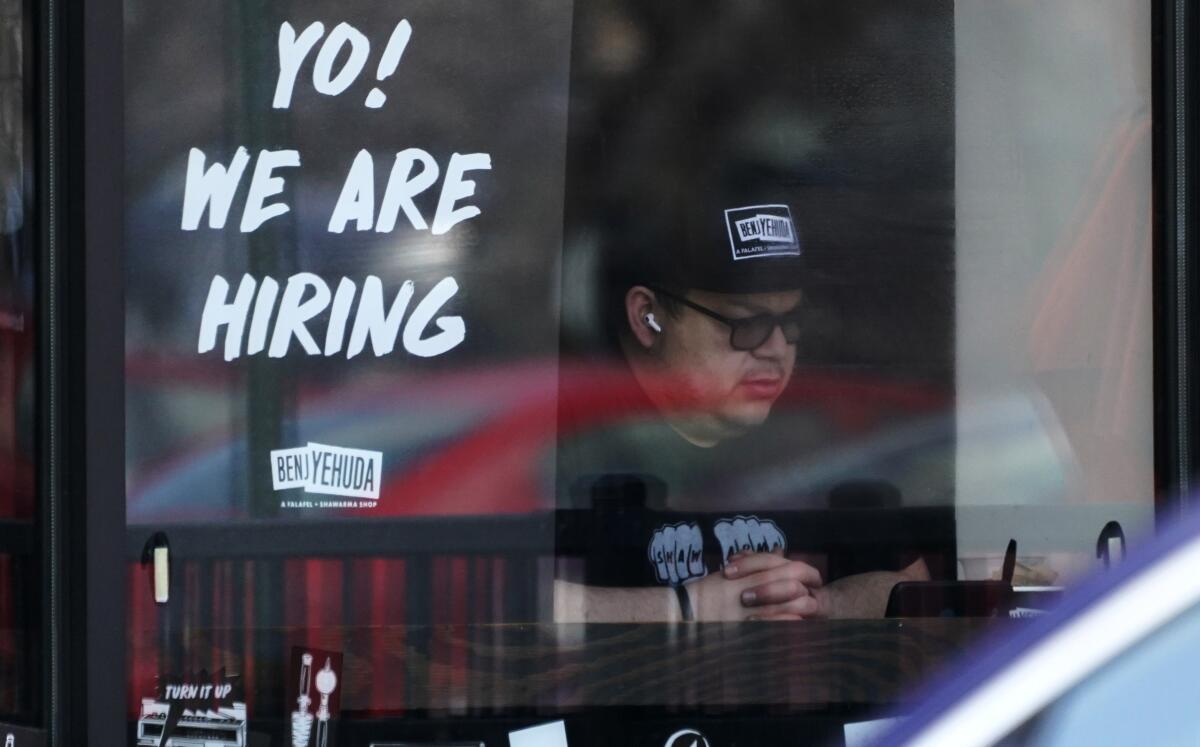U.S. added 428,000 jobs in April despite surging inflation

- Share via
WASHINGTON — Employers in the U.S. added 428,000 jobs in April, extending a streak of solid hiring that has defied punishing inflation, chronic supply shortages, the Russian war against Ukraine and much higher borrowing costs.
Friday’s jobs report from the Labor Department showed that last month’s hiring kept the unemployment rate at 3.6%, just above the lowest level in half a century.
The hiring gains have been remarkably consistent in the face of the worst inflation in four decades. Employers have added at least 400,000 jobs for 12 straight months.
At the same time, the April job growth, along with steady wage gains, will fuel consumer spending and probably keep the Federal Reserve on track to raise borrowing rates sharply to fight inflation.
The U.S. stock market slumped again Friday on concerns that the strength of the job market will keep wages and inflation high and lead to increasingly heavy borrowing costs for consumers and businesses. Higher loan rates could, in turn, weigh down corporate profits.
“With labor market conditions still this strong — including very rapid wage growth — we doubt that the Fed is going to abandon its hawkish plans,” said Paul Ashworth, chief U.S. economist at Capital Economics.
The employment figures did contain a few cautionary notes about the job market. The government revised downward its estimate of job gains for February and March by a combined 39,000. Additionally, the number of people in the labor force declined in April by 363,000, the first drop since September. Their exit slightly reduced the proportion of Americans who are either working or looking for work to 62.2% from 62.4%.
Many industries have been slowed by labor shortages. The nation remains 1.2 million jobs shy of the number it had in early 2020, just before the pandemic hammered the economy.
“We need those people back,” said Beth Ann Bovino, chief U.S. economist at S&P Global.
Bovino noted that some Americans are remaining on the sidelines of the workforce out of lingering concerns about COVID-19 or because of difficulty finding affordable day care for unvaccinated children.
In the meantime, employers keep handing out pay raises. Hourly wages rose 0.3% from March to April and 5.5% from a year ago. Prices, though, are rising faster than pay.
“Yes, we saw a bump in wages,” Bovino said. But with inflation at 40-year highs, “people are still squeezed.’’
Hiring was widespread last month across industries. Factories added 55,000 jobs, the most since last July. Warehouses and transportation companies added 52,000; restaurants and bars, 44,000; healthcare, 41,000; finance, 35,000; retailers, 29,000; and hotels, 22,000. Construction companies, which have been slowed by shortages of labor and supplies, added just 2,000.
It’s unclear how long the jobs boom will continue. The Fed this week raised its key rate by half a percentage point — its most aggressive move since 2000 — and signaled further large rate hikes to come. As the Fed’s rate hikes take effect, it will become increasingly expensive to spend and hire.
In addition, the vast economic aid the government had been supplying to households has expired, and Russia’s invasion of Ukraine has helped accelerate inflation and clouded the economic outlook. Some economists warn of a growing risk of recession.
For now, the resilience of the job market is particularly striking when set against the backdrop of galloping price increases and rising borrowing costs. This week, the Labor Department provided further evidence that the job market is still booming, reporting that only 1.38 million Americans were collecting traditional unemployment benefits, the fewest since 1970. It said employers posted a record-high 11.5 million job openings in March, and layoffs remained well below pre-pandemic levels.
What’s more, the economy has, on average, two available jobs for every unemployed person — the highest proportion on record.
And in yet another sign that workers are enjoying unusual leverage, a record 4.5 million people quit their jobs in March, evidently confident that they could find a better opportunity elsewhere.
More to Read
Inside the business of entertainment
The Wide Shot brings you news, analysis and insights on everything from streaming wars to production — and what it all means for the future.
You may occasionally receive promotional content from the Los Angeles Times.








